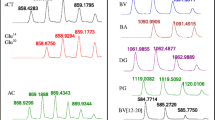Abstract
Purpose. Two calcitonins, i.e. human calcitonin (hCT) and, for comparison, salmon calcitonin (sCT), were chosen as peptide models to investigate nasal mucosal metabolism.
Methods. The susceptibility of hCT and sCT to nasal mucosal enzymes was assessed by in-and-out reflection kinetics experiments in an in vitro model based on the use of freshly excised bovine nasal mucosa, with the mucosal surface of the mucosa facing the peptide solution. The kinetics of CT degradation in the bulk solution was monitored by HPLC. Peptide sequences of the main nasal metabolites of hCT were analyzed by using both liquid secondary ionization mass spectrometry (LSIMS), following HPLC fractionation of the metabolites, and matrix-assisted laser desorption ionization mass (MALDI) spectrometry. For sCT, the molecular weights of two major metabolites were determined by LC-MS with electrospray ionization.
Results. Both CTs were readily metabolized by nasal mucosal enzymes. In the concentration range studied metabolic rates were higher with hCT than with sCT. Presence of endopeptidase activities in the nasal mucosa was crucial, cleaving both calcitonins in the central domain of the molecules.
Conclusions. Typically, initial metabolic cleavage of hCT in nasal mucosa is due to both chymotryptic- and tryptic-like endopeptidases. The subsequent metabolic break-down follows the sequential pattern of aminopeptidase activity. Tryptic endopeptidase activity is characteristic of nasal sCT cleavage.
Similar content being viewed by others
REFERENCES
A. Hussain, J. Faraj, Y. Aramaki, and J. E. Truelove. Biochem. Biophys. Res. Comm. 133:923–928 (1985).
M. A. Hussain, C. A. Koval, A. B. Shenvi, and B. J. Aungst. Life Sci. 47:227–231 (1990).
S. Lang, R. Oschmann, B. Traving, P. Langguth, and H. P. Merkle. (TP4), J. Pharm. Pharmacol., accepted for publication 1996
D. F. Hunt, J. R. Yates, J. Shabanowitz, S. Winston, and C. R. Hauer. Proc. Natl. Acad. Sci. USA 83:6233–6237 (1986).
M. Karas and F. Hillenkamp. Anal. Chem. 60:2301–2303 (1988).
V. J. Wroblewsky, R. E. Kaiser, and B. W. Becker. Pharm. Res. 10:1106–1113 (1993).
F. Waldemeier, P. Graf, and M. Schär. Treffen Pharma-Peptide und Proteine, Zürich. (1993).
A. E. Pontiroli, M. Alberetto, A. Calderara, E. Pajetta, and G. Pozza. Eur. J. Clin. Pharmacol. 37:427–430 (1989).
H. Kurose; Y. Seino, M. Shima, H. Tanaka., M. Ishida, K. Yamaopka, and H. Yabuchi. Calcif. Tissue Int. 41:249–251 (1987).
G. Ditzinger, J. Sandow, and H. P. Merkle. Proceed. Intern. Symp. Contr. Rel. Bioact. Mater. 17:220–221 (1990).
T. Arvinte, A. Cudd, and A. F. Drake. J. Biolog. Chem. 268:6415–6422 (1993).
C. D. Yu, J. L. Fox, N. F. H. Ho, and W. I. Higuchi. J. Pharm. Sci. 68:1347–1357 (1979).
R. H. Buck and F. Maxl. J. Pharm. Biomed. Anal. 8, Nos. 8–12:761–769 (1989).
K. O. Börnsen, M. Schär, and E. Gassmann. Biol. Mass Spectrom. 20:471–478 (1991).
K. Morimoto, M. Miyazaki, H. Yamaguchi, and M. Kakemi. Proceed. Intern. Symp. Control. Rel. Bioact. Mater. 19:318–319 (1992).
M. Dohi, Y. Nishibe, Y. Makino, and Y. Suzuki. Proceed. Intern. Symp. Control. Rel. Soc. P:9, Kyoto, Japan (1993).
Author information
Authors and Affiliations
Rights and permissions
About this article
Cite this article
Lang, S.R., Staudenmann, W., James, P. et al. Proteolysis of Human Calcitonin in Excised Bovine Nasal Mucosa: Elucidation of the Metabolic Pathway by Liquid Secondary lonization Mass Spectrometry (LSIMS) and Matrix Assisted Laser Desorption lonization Mass Spectrometry (MALDI). Pharm Res 13, 1679–1685 (1996). https://doi.org/10.1023/A:1016492723930
Issue Date:
DOI: https://doi.org/10.1023/A:1016492723930




